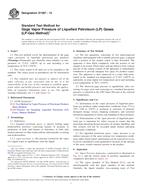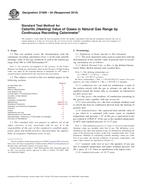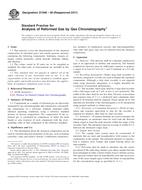Potřebujeme váš souhlas k využití jednotlivých dat, aby se vám mimo jiné mohly ukazovat informace týkající se vašich zájmů. Souhlas udělíte kliknutím na tlačítko „OK“.
ASTM D2158-11
Standard Test Method for Residues in Liquefied Petroleum (LP) Gases
Automaticky přeložený název:
Standardní zkušební metoda pro rezidua v zkapalněných ropných plynů (LP)
NORMA vydána dne 1.1.2011
Informace o normě:
Označení normy: ASTM D2158-11
Poznámka: NEPLATNÁ
Datum vydání normy: 1.1.2011
Kód zboží: NS-19461
Počet stran: 6
Přibližná hmotnost: 18 g (0.04 liber)
Země: Americká technická norma
Kategorie: Technické normy ASTM
Kategorie - podobné normy:
Anotace textu normy ASTM D2158-11 :
Keywords:
contaminants, liquefied petroleum gases, LPG, oil stain, residue, LPG (liquefied petroleum gases), Oil stain observation, Residue--petroleum products, ICS Number Code 75.160.30 (Gaseous fuels)
Doplňující informace
| Significance and Use | ||||||||||
|
Control over the residue content (required by Specification D1835) is of considerable importance in end-use applications of LPG. In liquid feed systems residues can lead to troublesome deposits and, in vapor withdrawal systems, residues that are carried over can foul regulating equipment. Those that remain will accumulate, can be corrosive, and will contaminate following product. Water, particularly if alkaline, can cause failure of regulating equipment and corrosion of metals. |
||||||||||
| 1. Scope | ||||||||||
|
1.1 This test method covers the determination of extraneous materials weathering above 38°C that are present in liquefied petroleum gases. The extraneous materials will generally be dissolved in the LPG, but may have phase-separated in some instances. 1.2 Liquefied petroleum gases that contain certain anti-icing additives can give erroneous results by this test method. 1.3 Although this test method has been used to verify cleanliness and lack of heavy contaminants in propane for many years, it might not be sensitive enough to protect some equipment from operational problems or increased maintenance. A more sensitive test, able to detect lower levels of dissolved contaminants, could be required for some applications. 1.4 WARNINGMercury has been designated by many regulatory agencies as a hazardous material that can cause central nervous system, kidney and liver damage. Mercury, or its vapor, may be hazardous to health and corrosive to materials. Caution should be taken when handling mercury and mercury containing products. See the applicable product Material Safety Data Sheet (MSDS) for details and EPA’s websitehttp://www.epa.gov/mercury/faq.htmfor additional information. Users should be aware that selling mercury and/or mercury containing products into your state or country may be prohibited by law. 1.5 The values stated in SI units are to be regarded as standard. No other units of measurement are included in this standard. 1.6 This standard does not purport to address all of the safety concerns, if any, associated with its use. It is the responsibility of the user of this standard to establish appropriate safety and health practices and determine the applicability of regulatory limitations prior to use. |
||||||||||
| 2. Referenced Documents | ||||||||||
|
Podobné normy:
Historická
1.11.2012
Historická
1.5.2010
Historická
1.5.2013
Historická
1.10.2011
Historická
1.11.2011
Historická
1.1.2014
Doporučujeme:
Aktualizace technických norem
Chcete mít jistotu, že používáte pouze platné technické normy?
Nabízíme Vám řešení, které Vám zajistí měsíční přehled o aktuálnosti norem, které používáte.
Chcete vědět více informací? Podívejte se na tuto stránku.



 ASTM D1267-12
ASTM D1267-12 ASTM D1826-94(2010)..
ASTM D1826-94(2010).. ASTM D1835-13
ASTM D1835-13 ASTM D1837-11
ASTM D1837-11 ASTM D1946-90(2011)..
ASTM D1946-90(2011).. ASTM D2163-14e1
ASTM D2163-14e1
 Cookies
Cookies
